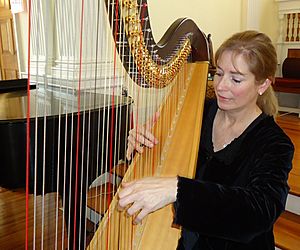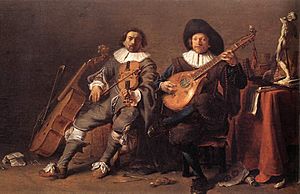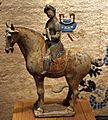Chordophone facts for kids

A chordophone is a musical instrument that makes sound by way of a vibrating string or strings stretched between two points.
What many would call string instruments are classified as chordophones. Violins, guitars, lyres, and harps are examples.
Contents
How chordophones work
When a chordophone is played, the strings vibrate and interact with each other. There is usually something that makes the sound resonate, such as the body of a guitar or violin. The strings are set into motion by either plucking (like a harp), strumming (like a guitar), by rubbing with a bow (like a violin, cello or double bass), or by striking (like a piano or berimbau). Common chordophones are the banjo, cello, double bass, dulcimer, guitar, harp, lute, piano, sitar, ukulele, viola and violin.
Origins and development
A 3,300-year-old stone carving of a Hittite bard playing a stringed instrument is the oldest iconographic representation of a chordophone and clay plaques from Babylonia show people playing an instrument that has a strong resemblance to the guitar, indicating a possible Babylonian origin for the guitar.
List of chordophones
- Banjo
- Cello
- Citole
- Clavichord
- Clavinet
- Crwth
- Cuban tres
- Double bass
- Gittern
- Guitar
- Dulcimer
- Harp
- Hurdy-gurdy
- Lyre
- Lute
- Monochord
- Piano
- Psaltery
- Rebec
- Rote
- Sitar
- String drum
- Ukulele
- Veena
- Vielle
- Viol
- Viola
- Violin
Images for kids
-
Viol, fidel and rebec (from left to right) on display at Amakusa Korejiyokan in Amakusa, Kumamoto, Japan
-
A woman playing some kind of string instrument while riding a horse, Tang dynasty
-
The strings of a piano
See also
 In Spanish: Instrumento de cuerda para niños
In Spanish: Instrumento de cuerda para niños








